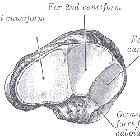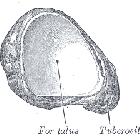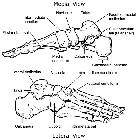Navicular
 ähnliche Suchen
ähnliche Suchen siehe auch
siehe auchThe navicular bone is found in the midfoot and is one of the tarsal bones. Its structure resembles that of a boat. It is the last bone of the foot to ossify fully .
Summary
- location: lies within the medial aspect of the midfoot
- relations: the talus bone, cuboid bone and the three cuneiform bones
- blood supply: branches of the dorsalis pedis, posterior tibial and medial plantar arteries
Gross anatomy
Articulations
The navicular bone articulates proximally with the head of the talus bone, laterally with the cuboid bone and also distally to the lateral, intermediate and medial cuneiform bones .
Attachments
It gives attachments to the superomedial and inferior calcaneonavicular ligament which together form the spring ligament within the foot .
Musculotendinous
The posterior tibialis tendon inserts into the navicular bone medially .
Ligamentous
The dorsal cuneonavicular ligament and plantar cuneonavicular ligament are two ligaments that join each cuneiform bone to the navicular. The first/medial cuneiform bone also is joined to the navicular by the medial cuneonavicular ligament .
Blood supply
A branch of dorsalis pedis artery gives off three to five smaller branches which supply the navicular from the medial side. On the lateral aspect of the bone, small branches from the posterior tibial artery. Branches of the medial plantar artery also supply the plantar surface of the bone . In the central navicular there is a region of watershed blood supply which predisposes the bone to stress fractures.
Variant anatomy
An accessory ossicle can be present on the medial aspect of the navicular known as an accessory navicular.
Development
Abnormalities of the ossification of the navicular can be common. The navicular is the last bone in the foot to ossify. In girls, the navicular anlage ossifies between 18-24 months and in boys 30-36 months .
Related pathology
Siehe auch:
- akzessorische Knochen Fuß
- Os tibiale externum
- Os naviculare cornutum
- Os supranaviculare
- Geist Klassifikation Os tibiale externum
- Morbus Köhler I
- Ossikel
- Lawson-Klassifikation
und weiter:
 Assoziationen und Differentialdiagnosen zu Os naviculare pedis:
Assoziationen und Differentialdiagnosen zu Os naviculare pedis:

















